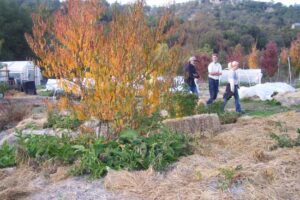Bill Wilson, the teacher of my Permaculture Design Certification Course (PDC), said that “permaculture is a creative and artful way of designing our lives, where wastes become resources, productivity and yields increase, work is minimized, people and nature are preserved – all by thoughtful planning and a respectful approach to life. Thus embraced, we create an environment where all may thrive for untold generations.”
Every single person on this planet can benefit from learning about permaculture and applying it in their lives and communities. Permaculture practitioners are greatly needed in the world today because they are directly solving global issues such as social inequity, soil infertility, climate change, water and food shortages.
A (PDC) course is a wonderful way to trains you how to be a practitioner of permaculture. Students deepen their ecological literacy and gain practical skills. It is a 72-hour or longer training that provides an internationally recognized certificate.
I always tell people that I won’t try to talk them into taking our PDC, but just to take a PDC. Any PDC can be life transforming. Any PDC will offer a formalized educational opportunity and an internationally recognized certificate. Shameless plug: you can learn more about the special offerings in our PDCs here.
Below are 10 reasons to take a PDC.
1. Transform how you look at the world
PDC students learn how to read social systems and landscapes in ways that see challenges as opportunities. Students learn how to assess hydrology, landforms, climate, sun exposure and more, which will help them determine the parameters for effective sustainable design.

2. Gain practical knowledge and experience.
A permaculture design certification is like a kickstart on the permaculture path. It goes deep into permaculture design methods. It is also a great life experience and can also serve as a good resume builder.It can enrich your career path
There are so many aspects of permaculture that can be persued. The permaculture career path is like a tree, with each branch presenting opportunities for income and right livelihood.
3. Solve real-world problems
Permaculture Design Courses offer a simple yet effective model for design. They offer a structure and method to fall back on when designing to address the challenges of our time. For example, the video below shows how permaculture designers have addressed challenges such as water shortage.
4. The world desperately needs more permaculturists
A PDC shows you ways to leave the earth better than you found it, and that is something that the world really needs right now.
5. Enrich any career path
Many PDC graduates end up working in environmental restoration, community projects, organic farms or homesteads. People who already have jobs can benefit from applying their permaculture knowledge to increase efficiency and find more meaning in their current field of work.
6. Gain a constructive outlet for creative passions.
Permaculture designs are not only functional; they are beautiful. Whether you are designing a community garden or sustainable home, there is lots of room for creativity and aesthetics in any permaculture design.

6. Meet people with similar passions
Most students who end up taking a PDC are there because they are interested in and passionate about similar interests such as organic gardening, community resilience, nature connection, environmental activism, alternative economies, experiential education… the list goes on. Taking a PDC is a great way to meet like-minded individuals and build your network of change-makers.
7. Foster symbiotic relationships
Permaculture is all about positive relationship. A PDC teaches you how to live in positive interactions with nature and fellow humans in your life.
“Permaculture is about rebuilding much needed relationships with the people, land and systems that support us.”
– Jono Neiger, The Permaculture Promise

8. Get Inspired
You will learn a lot about people and projects that are doing really, really inspiring work. Many students leave PDCs feeling motivated with a renewed sense of purpose in life.
10. Have fun!
Permaculture Design Courses are packed full of engaging learning activities and interactions that are both stimulating and nourishing to our innate needs for communication, community, positive action, learning, and fun!

Colin Eldridge
Colin is the founder of Fractal Permaculture. He is a trained permaculture designer and teacher. He teaches participatory and interactive classes around topics such as permaculture, art, social justice, nature awareness, holistic health, yoga and ecology.
More from our Blog

Permaculture and Yoga Ethics
There is a strong ethical congruence between Yoga and permaculture. Both disciplines are sciences that bolster the philosophy of non-violence, non-greed and right livelihood. Living in…
Read More
10 Reasons to take a PDC
Bill Wilson, the teacher of my Permaculture Design Certification Course (PDC), said that “permaculture is a creative and artful way of designing our lives, where…
Read More
5 Tips for Tending a Winter Garden
The below article was originally posted on the Sivananda Yoga Farm permaculture blog. You can view the original post here. There are so many benefits…
Read More

